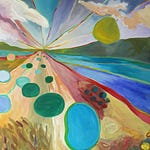The last line from George Leonard’s Mastery is a fitting place to pick up the ball and run with it this week.
Are you willing to wear your white belt? ~ George Leonard, Mastery: The Keys to Success and Long-Term Fulfillment
As I’ve been working and working and working, grinding away in execution mode to “abstract” an appropriate amount over the past month or so, I’ve actually begun to feel the abstraction occur.
I’ve made it to the next level in my own education, somewhere between ed and tech. The next level, of mastery?
A few notes before we get into it.
It’s really important to love the plateau. To aim for mastery is to love the plateau.
However, it’s also important that once you achieve the next level of mastery (in other words, once you abstract), you don’t simply do what you’ve always done on the previous plateau.
What’s more is that at the same time you must abstract, you must be conscious in your understanding of what to take with you to the next level of your journey, and what to discard and burn as deadwood.
It’s been too often that I, in my haste to achieve “the next level,” will rush into a handoff that’s not quite accomplished, or leave a job that was deserving of further commitment. Sometimes, I won’t even notice the fumble that results until much later. This is the chasing shiny things problem.
Finally, when you are working with a team on mastery of something extremely complex (like a high-growth startup), it’s of critical importance to understand what is to be abstracted from, what is to be kept as your personal domain of mastery, and on what time scale both should occur.
In short, mastery is hard. We must all be willing to put back on our white belts, symbolizing that we are in fact novices, beginners, and amateurs, today. To do this every day is to truly be on the path.
Slowing Down to Ramp Up
Each time a step up is achieved, it’s important to take a few moments to survey the “Valley below.” Developing a new and improved vantage point from your place further up the mountain and along the path allows you to see the landscape - the one that’s always been there - in a new way. Some slow, conscious attention, some quiet deliberation, and some reflection on the journey from the previous state to where we are now is in order.
Let me make this concrete.
This new system of people and resources that we’ve constructed to simultaneously scope, build, deploy, run, and continuously improve online cohort-based courses with an asynchronous team of instructional staff is now minimally viable.
We’ve built the engine and turned it on. It’s running!
While an infinite number of tweaks, breakdowns, fixes, and all-out resto-mods inevitably lie ahead, we’ve proven that this thing that we’re doing - it’s actually doable. We can build what we’re aiming at, I just know it. And I can feel it.
A couple of caveats:
Automating a system with nothing but humans is the OG approach to scaling a business, and is hardly automation at all in any real sense in 2022. That being said, intimations of scalability are dancing like sugarplums in my head.
Though I’m seeing inklings of successful product scaling, distribution trumps all in this game that we’re playing, especially in this economy.
All that is to say, there is still much work to be done!
Beginner’s Mind-Zen Mind
So with this new bandwidth and vantage point, where should a Head of Product somewhere between ed and tech shift their attention to? This is the essence of strategy.
First, and most importantly, I mustn’t rush into a handoff of responsibilities too quickly. This is especially a problem, it seems, for my particular personality type, which I was reminded of with a great work-personality assessment that someone on the team recommended to me, the StandOut Assessment.
You throw people in the deep end…you believe that being adventurous is the best way to learn.
That I do, StandOut, that I do.
So I must balance this proclivity of mine to throw others into the deep end with giving enthusiastic people the right amount of responsibility. Overdoing it leads to decreased productivity, destroyed enthusiasm, and in the worst case, burnout that halts the momentum of our minimum viable course-creation machine.
Some of the things on my list are to dig deeper into the data that we have and that we’re generating each week, and to expand partnerships that create value for students and companies alike.
Meanwhile, engaging successful ed-tech product people who have walked further down the path of mastery than I in their career has a deep resonance with me at this point in my journey. From building a product to building successful products, to building an organization, company, and even an industry, I’m fascinated by those who have come before me in this burgeoning space of ed-tech. (Check out Gib Biddle’s awesome post “What Your Next Head of Product Looks Like.”). If I’m honest with myself, I’m somewhere between building a product and building a successful product at the moment.
Many challenges lie ahead, not least those that every tech startup in the valley and around the world faces after the recent tech stock and layoff insanity. But these are all just challenges that, as an optimistic early career product leader, I very much look forward to doing my best to tackle head-on with plenty of “fire in the belly.”
Amidst the array of activities ahead, from product marketing to sales support to road mapping and product visioneering, to taking apart what we’ve built so as to reinforce the basic course-creation engine and make it a stronger RS-version, there is so much to look forward to as I wake up each day and put the white belt on, somewhere between ed and tech.
















